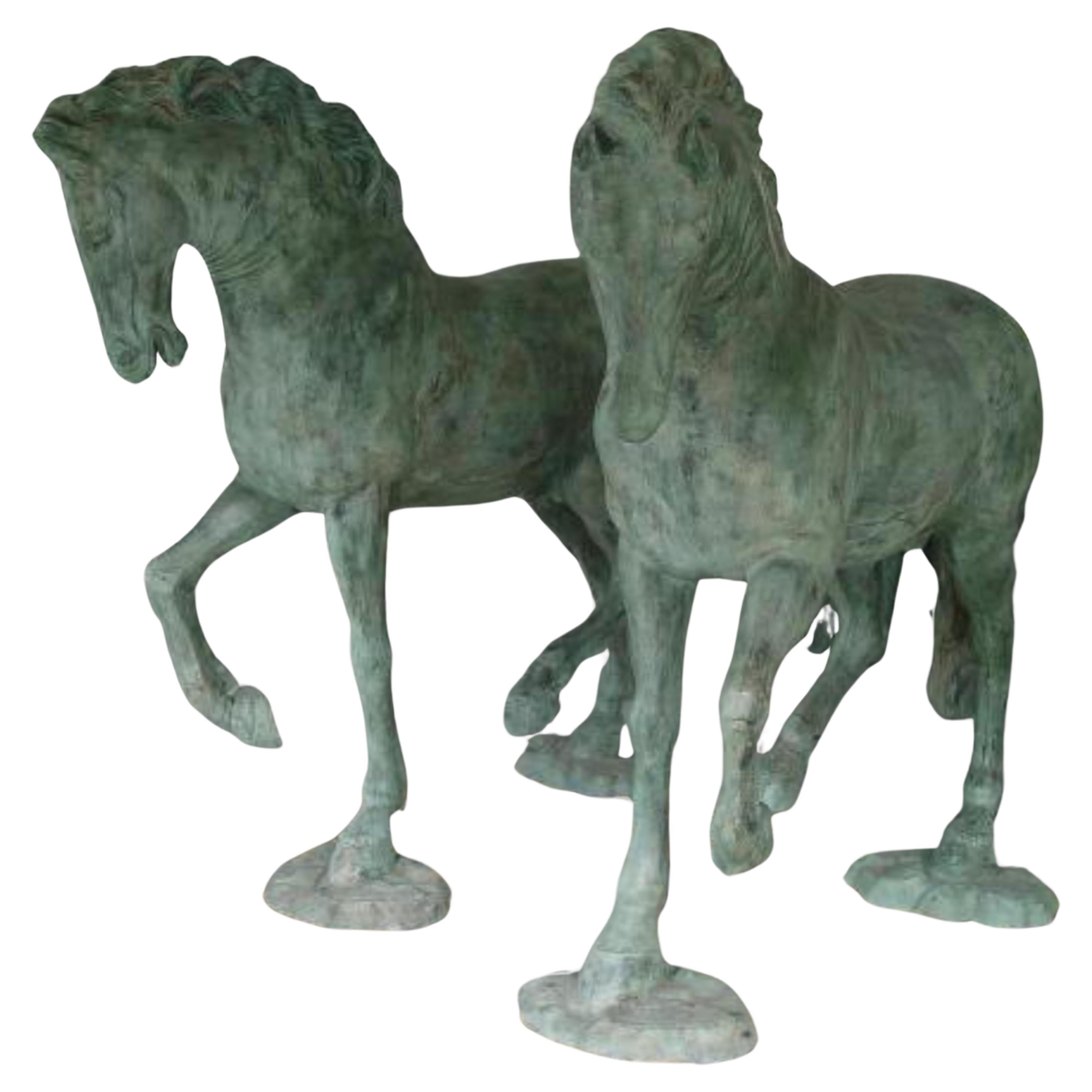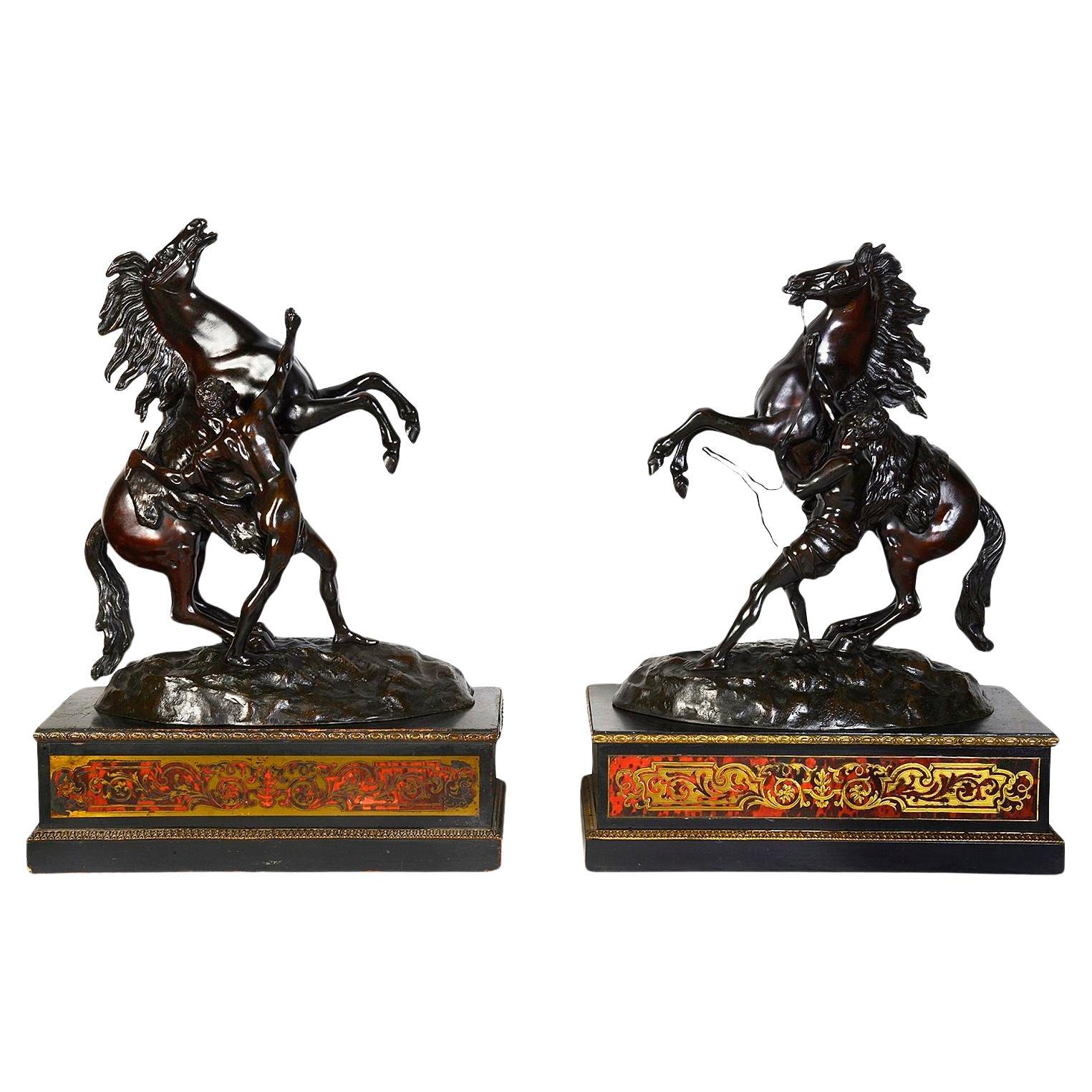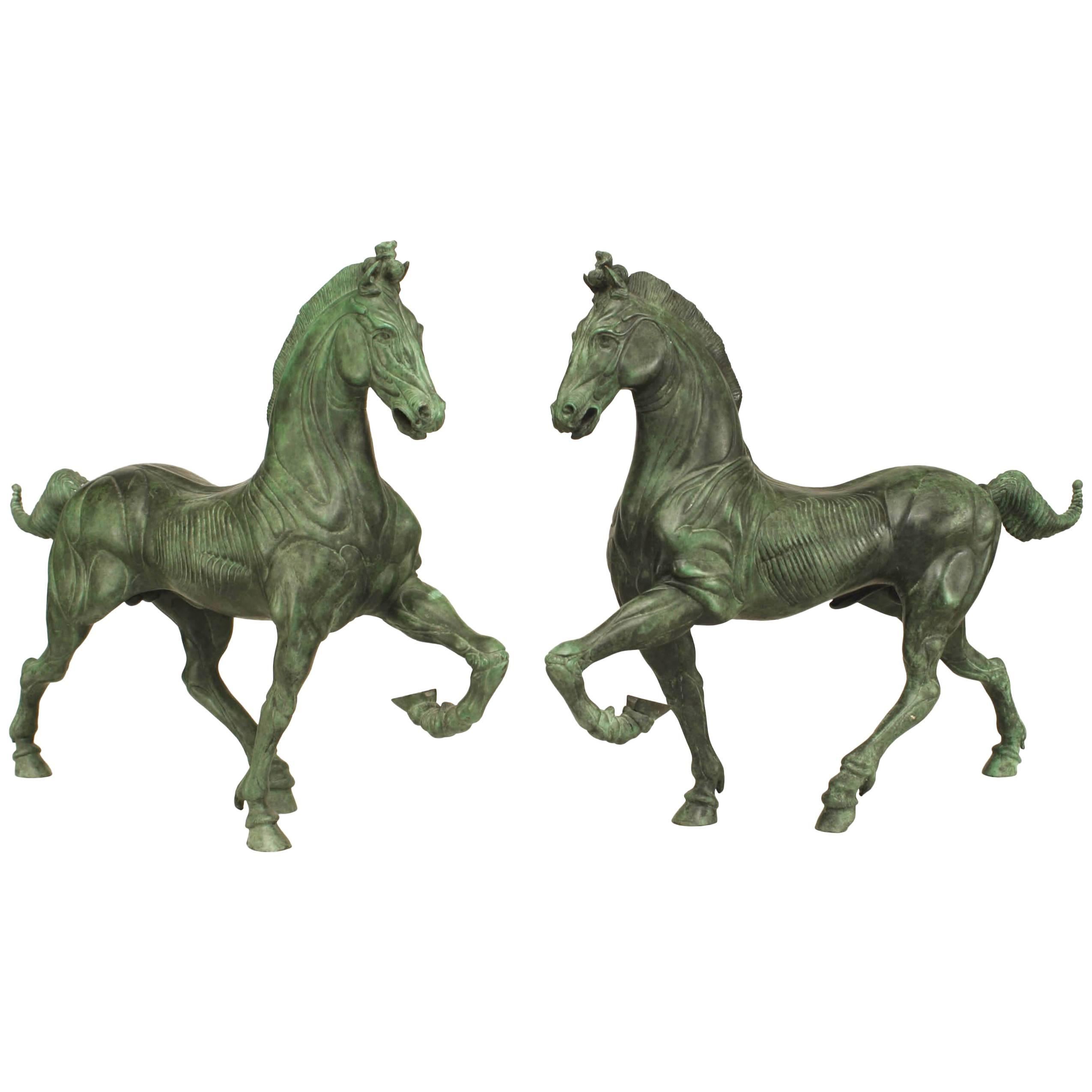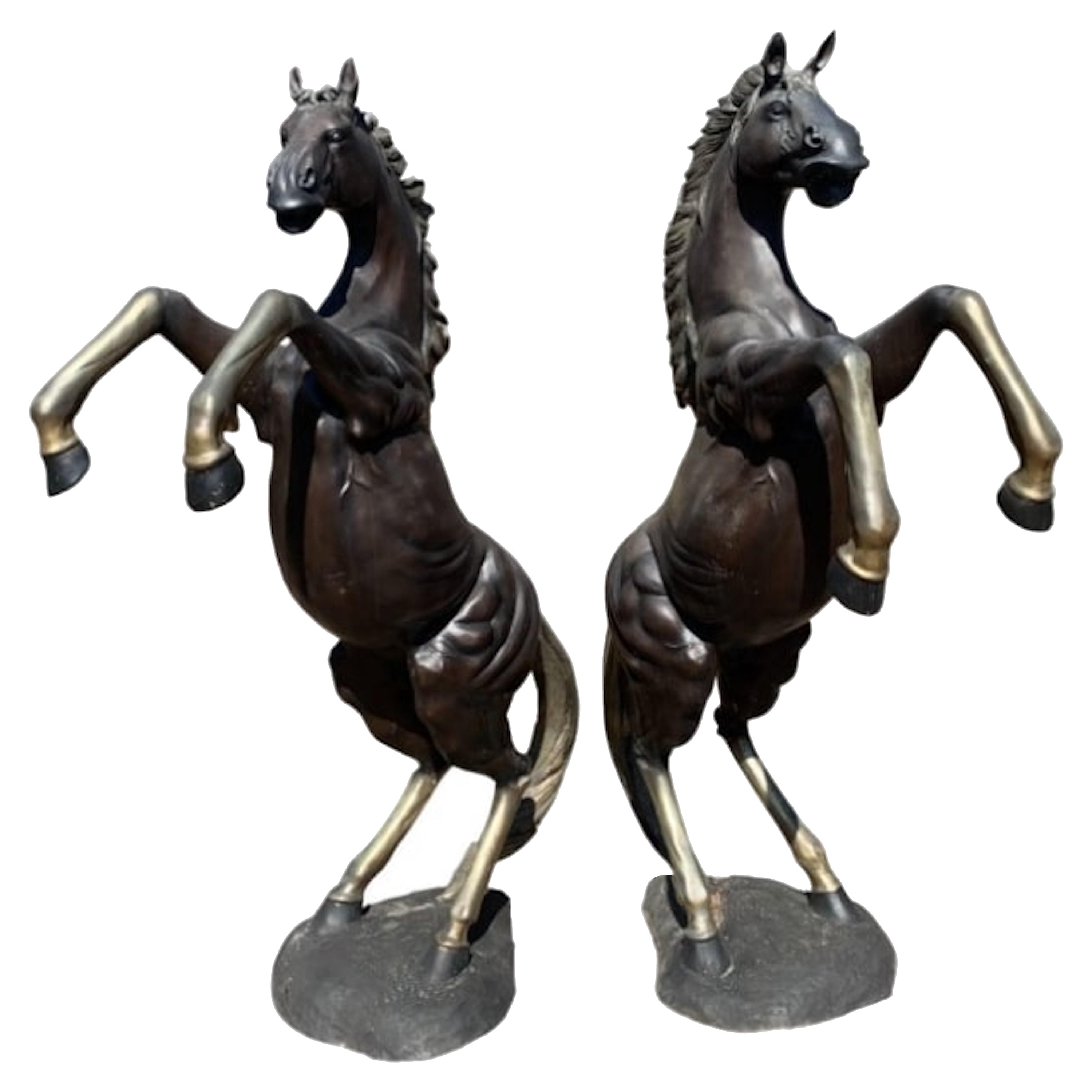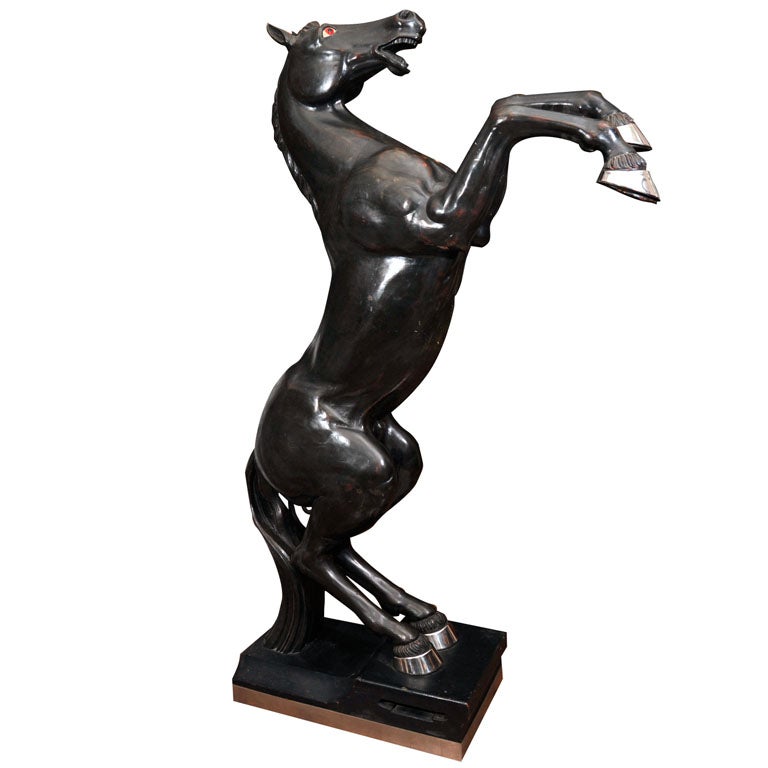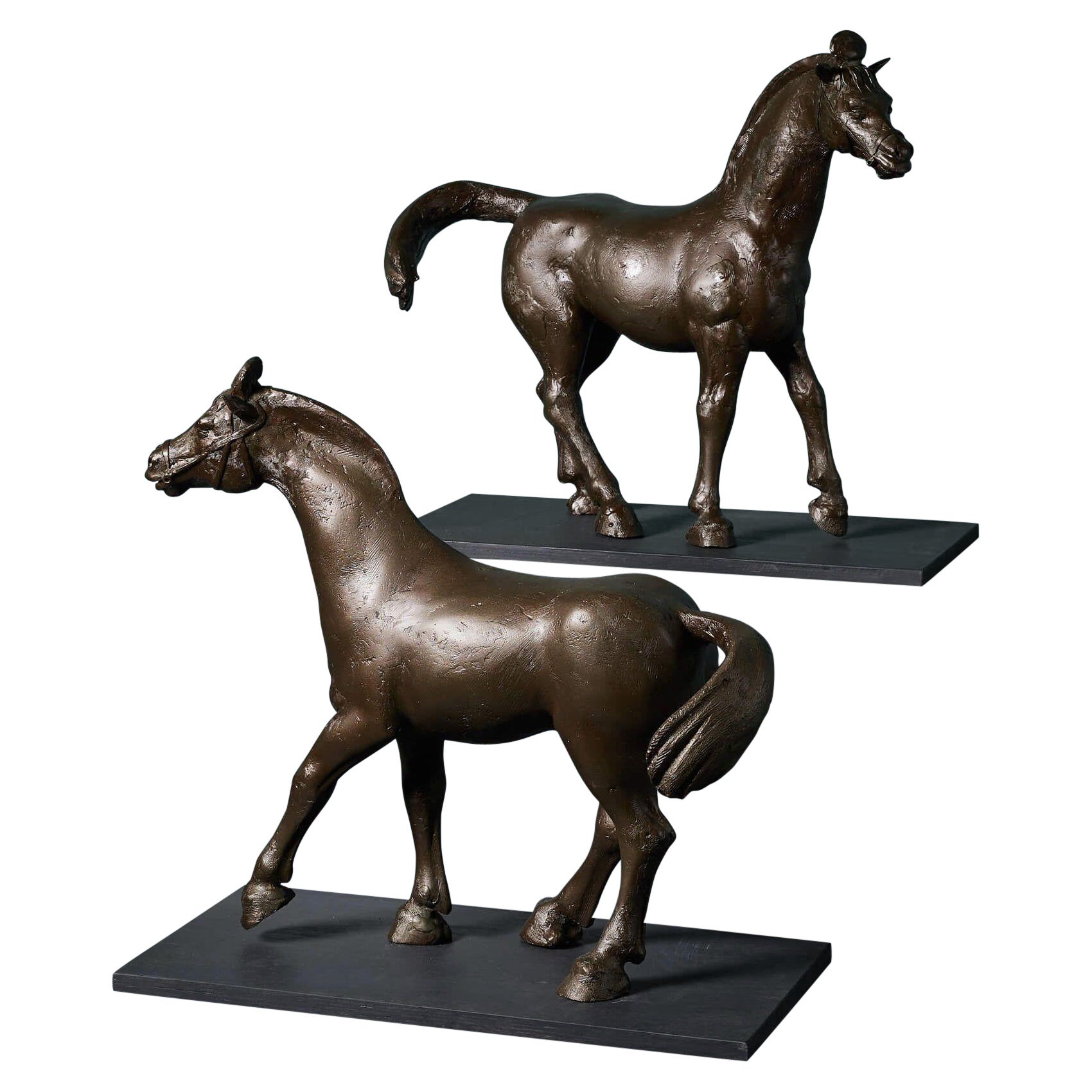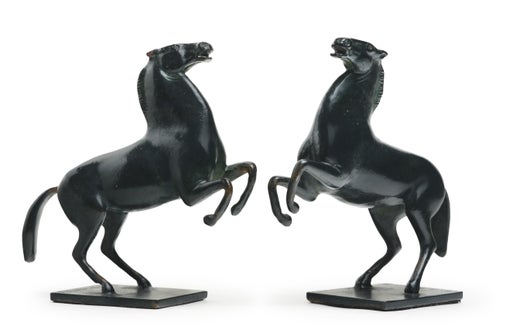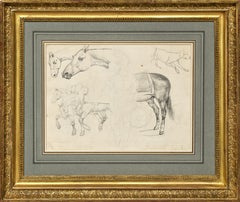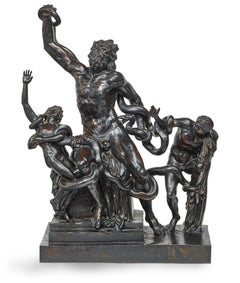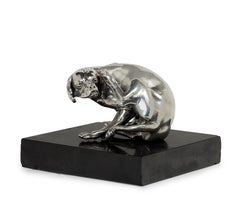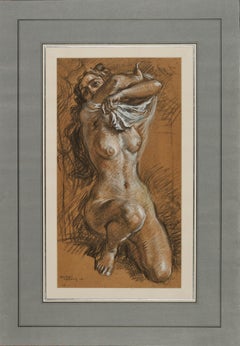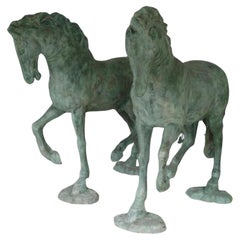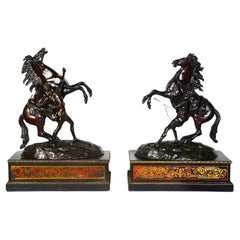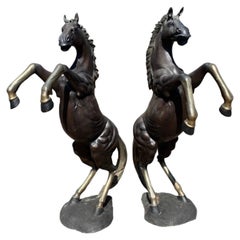Items Similar to Pair of Prancing Horses, two bronzes signed and numbered by Arno Breker
Want more images or videos?
Request additional images or videos from the seller
1 of 13
Arno BrekerPair of Prancing Horses, two bronzes signed and numbered by Arno Breker1978
1978
$3,325.78
£2,479.14
€2,800
CA$4,635.67
A$5,038.17
CHF 2,662.48
MX$60,951
NOK 33,159.25
SEK 31,320.97
DKK 21,323.27
About the Item
An official artist of the Nazi regime, trained in Montparnasse in the 1930s, Arno Breker continued to sculpt after the fall of the Third Reich, producing large-scale public commissions in Germany and portraits of prominent figures. The two small bronzes presented here, dated around 1978, are part of a long tradition of prancing horses dating back to antiquity. The asymmetrical treatment of the two front legs and the inclination of the head make these two copies of the same artwork a highly decorative pair.
1. Arno Breker, a prolific sculptor, from the Bohemia of Montparnasse to the commissions from the Third Reich ... and from the Federal Republic of Germany
The son of a stone carver, Arno Breker studied fine art and anatomy in his native Elberfeld. At the age of 20, he entered the Düsseldorf Academy of Art. He moved to Paris in 1926, where he continued his training in the studio of Maillol, who dubbed him "the German Michelangelo of the twentieth century". He shared a studio with Alexandre Calder and frequented Jean Cocteau, Foujita, Brancusi, Pablo Picasso and other artists of the bohemian Paris of the time. It was also in Paris in 1933 that he met Demetra Messala, the daughter of a Greek diplomat who posed for Maillol and Picasso, whom he married in 1937. Having won the Prussian Prix de Rome in 1932, he left Paris to stay at the Villa Massimo, the German Academy in Rome.
Returning to Germany in 1934, his style evolved towards a more marked imitation of ancient sculpture. He created two monumental statues for Berlin's Olympic Stadium, before being appointed professor at the Berlin College of Fine Arts in 1937. He came to the attention of the Reich Propaganda Ministry, which awarded him several commissions and provided him with three large studios in which Breker produced many monumental sculptures to the glory of the regime. On June 23, 1940, Breker accompanied Adolf Hitler during a visit to Paris. During the Occupation, his political connections enabled him to intervene on behalf of many artists pursued by the Nazis: for example, he protected Pablo Picasso (then a Communist) from Kommandantur officers.
Most of Arno Breker's work was destroyed in Berlin at the end of the war in 1945 by bombing and intentional destruction perpetrated by soldiers of the victorious powers. After the fall of the Nazi regime, however, Arno Breker was never prosecuted. He opened a new studio in Düsseldorf, where he sculpted until his death in 1991.
He then carried out several public commissions in Germany (Bayreuth, Wuppertal), as well as portraits of numerous personalities, including King Mohammed V of Morocco, Léopold Sedar Senghor (commissioned by the Académie Française in 1978) and the two chancellors of the Federal Republic of Germany, Konrad Adenauer and Ludwig Erhard. The Arno Breker Museum in Nörvenich is now exhibiting some of his artworks.
2. Related artworks: from the Wild Horses of the Quirinal to the Horses of Marly
The prancing horse is a major iconographic theme, found in a series of sculptures from Antiquity, the Renaissance and the Classical Age. Various photos from Arno Breker's studio in Berlin confirm the predominant place of equine representations in his work (alongside male nude statues), and confirm that this reduced version created in 1978 is part of the artist's preferred repertoire.
Prancing horses are generally associated with a male figure in a group that, through a reference drawn from Antiquity, symbolizes man's domination over nature. In this respect, it is very interesting to compare our small bronzes with the horse forming part of a large sculpture by Arno Breker (made in 1936 and probably destroyed in 1945) depicting Alexander taming Bucephalus.
This statue is itself directly inspired by one of the best-known works of 18th-century French sculpture: the famous "Chevaux de Marly" (Horses of Marly - 9th photo in the gallery) , created by Guillaume Coustou and his workshop in 1745, two symmetrical groups each representing a rearing horse held by a groom. Intended for the decoration of the watering hole at Marly, they are now in the Louvre Museum, having long adorned the lower part of the Avenue des Champs-Elysées on the Place de la Concorde (where they have now been replaced by copies).
As the groom is completely hidden behind the prancing horse's body, it is very interesting to compare our little bronze with a view of the other group taken without the groom (10th picture in the gallery).
In addition to the similarities in the horse's position, the treatment of the horse's mane and tail demonstrates a desire to simplify forms, reminiscent of earlier models that may have inspired Coustou himself. This simplification brings our statuettes closer to one of the most famous antique models: the two gigantic groups of horse tamers, sometimes called Dioscuri, which adorn the fountain in front of the Quirinal Palace in Rome. Nearly 5.60 meters high, they were created in Roman times and come from Constantine's Baths. They were inspired by Greek originals that have since disappeared. It is particularly interesting to compare the treatment of the horse's mane with that of the mane on our statues, confirming Arno Breker's inspiration after the antique.
Exhibited in public spaces and widely reproduced in prints from the Renaissance onwards, these horses from the Quirinal are probably the matrix from which this theme was frequently represented, as shown by a sculpture housed in the Kunsthistorisches Museum in Vienna, one of the earliest examples (last picture in the gallery). This sculpture by Bertoldo di Giovanni (after 1420 - 1491), entitled Bellerophon taming Pegasus, represents a variation on the same theme, adapted to this mythological episode by the addition of wings to the horse representing Pegasus.
- Creator:Arno Breker (1900 - 1991, German)
- Creation Year:1978
- Dimensions:Height: 4.88 in (12.4 cm)Width: 4.75 in (12.07 cm)Depth: 2 in (5.08 cm)
- Medium:
- Movement & Style:
- Period:
- Condition:Dimensions: height 4 7/8’’ x width 4 3/4” x depth 2’’ (12.5 x 12 x 5 cm) Foundry mark: PK in a rhombus Signed and numbered 7/8 and 8/8 on the base.
- Gallery Location:PARIS, FR
- Reference Number:1stDibs: LU1568215981972
The son of a stone carver, Arno Breker studied fine art and anatomy in his native Elberfeld. At the age of 20, he entered the Düsseldorf Academy of Art. He moved to Paris in 1926, where he continued his training in the studio of Maillol, who dubbed him "the German Michelangelo of the twentieth century". He shared a studio with Alexandre Calder and frequented Jean Cocteau, Foujita, Brancusi, Pablo Picasso and other artists of the bohemian Paris of the time. It was also in Paris in 1933 that he met Demetra Messala, the daughter of a Greek diplomat who posed for Maillol and Picasso, whom he married in 1937. Having won the Prussian Prix de Rome in 1932, he left Paris to stay at the Villa Massimo, the German Academy in Rome. Returning to Germany in 1934, his style evolved towards a more marked imitation of ancient sculpture. He created two monumental statues for Berlin's Olympic Stadium, before being appointed professor at the Berlin College of Fine Arts in 1937. He came to the attention of the Reich Propaganda Ministry, which awarded him several commissions and provided him with three large studios in which Breker produced many monumental sculptures to the glory of the regime. On June 23, 1940, Breker accompanied Adolf Hitler during a visit to Paris. During the Occupation, his political connections enabled him to intervene on behalf of many artists pursued by the Nazis: for example, he protected Pablo Picasso (then a Communist) from Kommandantur officers. Most of Arno Breker's work was destroyed in Berlin at the end of the war in 1945 by bombing and intentional destruction perpetrated by soldiers of the victorious powers. After the fall of the Nazi regime, however, Arno Breker was never prosecuted. He opened a new studio in Düsseldorf, where he sculpted until his death in 1991. He then carried out several public commissions in Germany (Bayreuth, Wuppertal), as well as portraits of numerous personalities, including King Mohammed V of Morocco, Léopold Sedar Senghor (commissioned by the Académie Française in 1978) and the two chancellors of the Federal Republic of Germany, Konrad Adenauer and Ludwig Erhard. The Arno Breker Museum in Nörvenich is now exhibiting some of his artworks.
About the Seller
5.0
Vetted Professional Seller
Every seller passes strict standards for authenticity and reliability
Established in 2020
1stDibs seller since 2021
10 sales on 1stDibs
- ShippingRetrieving quote...Shipping from: PARIS, France
- Return Policy
Authenticity Guarantee
In the unlikely event there’s an issue with an item’s authenticity, contact us within 1 year for a full refund. DetailsMoney-Back Guarantee
If your item is not as described, is damaged in transit, or does not arrive, contact us within 7 days for a full refund. Details24-Hour Cancellation
You have a 24-hour grace period in which to reconsider your purchase, with no questions asked.Vetted Professional Sellers
Our world-class sellers must adhere to strict standards for service and quality, maintaining the integrity of our listings.Price-Match Guarantee
If you find that a seller listed the same item for a lower price elsewhere, we’ll match it.Trusted Global Delivery
Our best-in-class carrier network provides specialized shipping options worldwide, including custom delivery.More From This Seller
View AllDouble-sided Horse Studies by Théodore Géricault
By Jean Louis Andre Theodore Gericault
Located in PARIS, FR
Recto: two horses, preparatory study for the lithograph "Les Boueux" ("The Muddy Ones")
Verso: four studies of horse heads (including two preparatory studies for the watercolor "Plowing in England"), a study of a life guard with the rump of his horse (preparatory to the lithograph "A Party of Life...
Category
1820s Old Masters Animal Drawings and Watercolors
Materials
Carbon Pencil
Laocoön and his Sons, an exceptional bronze sculpture by Giacomo Zoffoli
Located in PARIS, FR
This exceptional bronze group (unpublished), executed in Rome in the second half of the 18th century, bears witness to the fascination with the Laocoön since its discovery on January...
Category
1770s Italian School Nude Sculptures
Materials
Bronze
Dog scratching its ear
Located in PARIS, FR
This amusing naturalistic sculpture in silver-plated pewter was probably made in the 17th century by Georg Schweigger. Inspired by a model created by another Nuremberg sculptor, Peter Flötner, it bears witness to the persistence during the baroque era of the naturalistic taste that emerged in the Renaissance. Intended as an ornament for some Kunstkammer, or cabinet of curiosities, this sculpture was a great success, as can be seen from the presence of similar works in many European museums.
1. Georg Schweigger
Georg Schweigger was a baroque sculptor and medal founder from Nuremberg, known mainly for his small-scale works in stone, carved wood and cast metal. His only large-scale work, the Neptune Fountain, has been in the Petershof Palace, the summer residence of the Tsars near St. Petersburg, since 1797. This monumental sculpture demonstrates his taste for the representation of movement, which we find in this small piece, inspired, as we shall see, by earlier models.
2. The success of a naturalistic theme
As is often the case in the history of art, the source of the Dog scratching his ear theme probably comes from an engraving, and more precisely from one made in Strasbourg in 1480 or in Aschaffenburg in 1481 by the Master of the Housebook, an anonymous engraver working in southern Germany at the end of the 15th century.
This engraving seems to have been Peter Flötner’s (1490 - 1546) source of inspiration. Peter Flötner was a sculptor and engraver who settled in Nuremberg in 1522. The Louvre Museum also has a gilded lead statuette dated between 1500 and 1515 (on deposit at the Musée de L'Œuvre in Strasbourg), which in turn is thought to have served as a model for other known statuettes.
This model was later taken up by the Frenchman Barthélemy Prieur...
Category
17th Century Naturalistic Figurative Sculptures
Materials
Marble, Silver
$6,354
Study for the Spring (preparatory to the Four Seasons) by René-Marie Castaing
Located in PARIS, FR
René-Paris Castaing, winner of the Grand Prix de Rome in 1924, left a large body of work, both sacred and secular. Many churches in the Pyrénées-Atlantiques, in South-West France still bear witness to the diversity of his talent. In 1942, he began a major decoration project for the Château de Diusse, in the north-east of the county, including an allegory of the four seasons. The vigorous pastel we are presenting here is a study for Spring, depicted as Flore undressing. This commission was a veritable swan song for the artist, who died a year later at the age of 47.
1. René-Marie Castaing, the great inter-war painter in Pau
René-Marie Castaing was born in Pau on December 16th 1896. His father, Joseph Castaing, was also a painter: he was the official portraitist of Pau's high society, which was particularly cosmopolitan at the end of the century, when many rich foreigners spent the winter in Pau, taking advantage of the mild weather to enjoy an outdoor lifestyle punctuated by hunting, horse ridings and golf.
René-Marie Castaing was admitted to the Ecole Nationale Supérieure des Beaux-Arts in Paris in April 1920 and entered the studio of Paul-Albert Laurens (1870-1934). In 1924, he was awarded the First Grand Prix de Rome for Painting, which earned him a stay at the Villa Médicis for more than three years. He then returned to Pau in 1928, where he lived until his death.
Castaing's work is marked by the academic tradition, in which drawing plays as important a role as painting. Although his drawings are often sketches that help to set up large painted compositions, they stand as independent artworks in which the artist fully expresses the vivacity of his talent.
Castaing was a fervent Christian and religious painting played an essential part in his work, as shown by the decorations he created for the churches of Bizanos, Borce, Bidache and Salies-de-Béarn. The painter also created several secular decorations, such as that for the dining room of the Villa Saint-Basil's in Pau in 1935, and the Hunting at the Albret’s time commissioned in 1940 by the Prefecture of Pau. The décor created in 1942-1943 for the Château de Diusse, a mansion located north-east of Pau, was his last large-scale décor, as the painter died shortly after its completion on December 8th 1943.
2. Description of the drawing
Our pastel depicts an eminently secular theme: Spring is embodied by Flore, crouching on the ground with one knee touching the ground. She reveals her ample bosom by removing her shirt, her arms raised above her shoulders to undress.
Given Castaing's classical training at the Beaux-Arts and the influence of ancient statuary...
Category
1940s Art Deco Nude Drawings and Watercolors
Materials
Pastel
Frieze of antique figures, a drawing by the sculptor Antoine-Denis Chaudet
Located in PARIS, FR
Faithful to the neo-classical taste, sculptor Antoine-Denis Chaudet presents us with a frieze of antique figures executed in gray wash over pencil strokes, which is likely inspired b...
Category
Early 1800s Old Masters Figurative Drawings and Watercolors
Materials
Paper, Pencil, Ink
Stag Hunting in the Vicinity of Nuremberg by a German Artist Peter von Bemmel
Located in PARIS, FR
This small landscape shows a hunting scene: two riders are chasing a stag with their dogs at the edge of a forest. Signed by Peter von Bemmel, it is typical of the production of this...
Category
1720s Old Masters Landscape Paintings
Materials
Copper
You May Also Like
Masterful Pair of Italian Horses in bronze 20th Century 1:1
Located in Madrid, ES
Masterful Pair of Italian Horses in bronze 20th Century 1:1
real height, lost wax casting.
Origin Venice, private collection.
Perfect for the outside or even for the inside.
The dim...
Category
20th Century Italian Modern Animal Sculptures
Materials
Bronze
Large Pair of 19th Century Bronze Marly Horses on Boulle Stands 32"(81cm)
By Guillaume Coustou
Located in Brighton, Sussex
A very impressive striking pair of French bronze Marly horses after Guillaume Coustou the elder 1677-1746. Mounted on ebonized, boulle inlaid pedestals.
Batch 80 N/H
Category
Antique 19th Century French Classical Greek Abstract Sculptures
Materials
Bronze
Pair of Green Patinated Bronze Horses
By Ludovico De Luigi
Located in Queens, NY
Pair of Italian Renaissance style green patinated bronze figure of horse walking (from a series of 1,000 titled: "Cavalli di San Marco II", signed by L...
Category
20th Century Italian Renaissance Animal Sculptures
Materials
Bronze
$12,000 / set
Pair of Bronze Horse Statues
Located in Brooklyn, NY
Gorgeous pair of bronze horse statues. Please confirm location with seller (NY or NJ)
Category
Mid-20th Century Mid-Century Modern Statues
Materials
Bronze
Maison Jansen Pair of Monumental, Electrified Horse Figures
By Maison Jansen
Located in Bridgewater, CT
A pair of rare and spectacular horse figured floor lamps in ebonized wood, design circa 1950 by Maison Jansen. Electrified, each upper hoof fitted with downlights, with red glass eye...
Category
Vintage 1950s French Mid-Century Modern Animal Sculptures
Materials
Chrome
$33,750 Sale Price / set
25% Off
John W. Mills (1933-2023) Pair of Tang Dynasty Horse Sculptures
By John Mills
Located in Wormelow, Herefordshire
A beautiful pair of Tang Dynasty style horse sculptures mounted on rectangular wooden bases by the acclaimed British sculptor, John W. Mills.
Ancient Tang Dynasty horses symbolised ...
Category
Late 20th Century English Mid-Century Modern Animal Sculptures
Materials
Resin, Wood
More Ways To Browse
Pair Of Art Deco Sculptures
Rearing Horse
18th Century French Sculpture
Prancing Horse
Art Deco Horse Sculpture
Pegasus Horse
Male Statue
Bronze Horse Signed
Wendy Saxon Brown
Wesley Fleming
Willem Degroot
William Debilzan
William Morris Glass Art
Winged Hat Hermes
Wladimiro Politano
3 Wise Monkeys
A Moreau Angels
Alex Katz Cut Out
